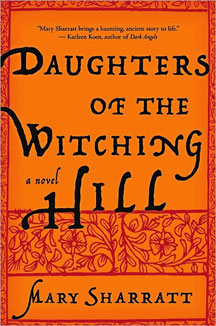 Daughters of the Witching Hill is set in Pendle Forest in Lancashire, England in the late 16th and early 17th centuries, spanning the reigns of Queen Elizabeth and King James.
Daughters of the Witching Hill is set in Pendle Forest in Lancashire, England in the late 16th and early 17th centuries, spanning the reigns of Queen Elizabeth and King James.
Discussion Questions
1. What did you learn about life in northern England during this time?
2. Comparing the Pendle Witch Trials to the more familiar Salem Witch Trials of 1692, what primary differences crop up in the social forces driving the two witch hunts?
3. Does book’s portrayal of magic and cunning folk in Early Modern Britain feel authentic to you? Did the book change any of your views on historical witchcraft?
4. This is how Thomas Potts describes Elizabeth Southerns, aka Mother Demdike, in his book, A Wonderfull Discoverie of Witches in the Countie of Lancaster, the official transcripts of the 1612 Pendle Witch Trial:
She was a very old woman, about the age of Foure-score yeares, and had been a Witch for fiftie yeares. Shee dwelt in the Forrest of Pendle, a vast place, fitte for her profession: What shee committed in her time, no man knows. . . . Shee was a generall agent for the Devill in all these partes: no man escaped her, or her Furies.
A cunning woman of longstanding repute, Bess Southerns earned her living by using her folk charms to heal humans and livestock. She practiced her craft for decades before anyone dared to interfere with her. Only at the age of eighty, near the end of her long and productive career, was she arrested on witchcraft charges. Why do you think this was?
5. Unlike many other accused witches in historical trials, Bess freely admitted to being a cunning woman, and she even bragged to the magistrate about her familiar spirit, Tibb, who appeared to her in the guise of a beautiful young man. Why didn’t Bess try to save herself by denying the accusations?
6. Who, or what, is Tibb, Bess’s familiar spirit? Do you see him as good, evil, or neutral? Does he ultimately benefit Bess or lead her into tragedy?
7. The cunning craft Bess practiced reveals a sincere faith in the power of Catholic prayer charms combined with folk beliefs in familiar spirits, sympathetic magic, and the Fairy Folk. Would you describe her worldview as ultimately Christian or Pagan? How does Bess’s spiritual vision differ from that of her fellow accused witch, Alice Nutter, a recusant Catholic, who concealed outlawed priests in her manor house?
8. “No part of England hath so many witches,” Edward Fleetwood wrote in his 1645 pamphlet describing Lancashire, “none fuller of Papists.” Why were Protestant authorities so eager to conflate Catholicism and witchcraft in this period? Why do you think so many people in Lancashire clung to the outlawed Catholic faith in the face of persecution and death?
9. This novel can be read as a study on how different women deal with power. As evidenced by the Thomas Potts quote above, Bess Southerns was so terrifying to her foes because she was a woman who embraced her perceived supernatural powers wholeheartedly. In contrast, her daughter Liza eventually rejects her powers, while Alizon, Bess’s granddaughter, views her own rising powers with abject terror and appears to do everything she can to deny them. Why is Alizon so reluctant to embrace her own power? What price does Alizon pay for this rejection? Do you identify more with Bess or Alizon?
10. After Bess instructs her best friend, Chattox, on the craft, Chattox turns to dark magic. Is Chattox justified in harnessing dark powers to protect her daughter, Anne Redfearn, from rape when she knows the authorities will do nothing to help her? What would you have done in Chattox’s situation?
11. Alizon’s brother, Jamie, suffers from learning difficulties. Outside the circle of his loving family, people call him an idiot and treat him callously. How does his affliction shape his fate?
12. What do you think is the origin of the “green sickness” that kills Alizon’s best friend, Nancy? How did the view of illness in this period mirror beliefs in witchcraft and the supernatural?
13. What do you think of magistrate Roger Nowell and his actions? Why is he so obsessed with witch-hunting? After having known about Bess and her magical activities for several decades, why does he wait until 1612 to make his move?
14. After Bess and Alizon’s arrest and imprisonment in Lancaster Castle, their worried family and friends meet at Malkin Tower to discuss their concerns. Roger Nowell arrests nearly everyone present at this gathering, accusing them of being a coven of witches and of conspiring to blow up Lancaster Castle with gunpowder. Why is it so important for Nowell to convince the authorities that there is a vast conspiracy of satanic witches threatening to undermine the social order? After arresting so many of Bess’s friends and relatives, why does Nowell spare Bess’s son Kit and his family?
15. Discuss the role of collective hysteria in the Pendle witch-hunt. How did ordinary people go from quiet co-existence to a state of mounting paranoia in which family members and neighbors were more than willing to denounce each other?
16. What do you think of nine-year-old Jennet Device and her betrayal of her family? What do you think happened to her after the trial that saw her mother and siblings hanged for witchcraft?
17. What enduring message does the Pendle Witch Tragedy have for people of our time?
![]()
Amazon | Amazon UK | Barnes & Noble | Books-a-Million | Indiebound | Powell’s
![]()
Book Excerpt | Reader’s Guide | Cast of Characters | Demdike’s Charms | Further Reading

